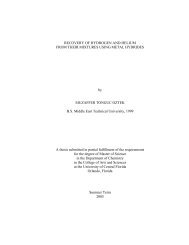You also want an ePaper? Increase the reach of your titles
YUMPU automatically turns print PDFs into web optimized ePapers that Google loves.
These parameters are generally interdependent. For example, the optimum milling<br />
time is affected by the type of mill, temperature, etc. Ball to powder ratio (BPR) and time<br />
of milling for a desired product are dependent on the capacity of the mill. For small<br />
capacity mills, BPR of 10:1 is reported to be the commonly used [47].<br />
Ball milling has been reported to activate FeTi, Mg 2 Ni and LaNi 5 , which are inert<br />
to hydrogen prior to milling. For FeTi, milling is believed to give rise to Fe rich clusters<br />
on the surface and the generation of new surfaces by cracking [49]. LaNi 5 has been<br />
synthesized from elemental La and Ni via milling at room temperature and, using a<br />
similar method, the partially substituted La 0.5 Zr 0.5 Ni 5 has been synthesized from an<br />
equimolar mixture of LaNi 5 and ZrNi 5 [48].<br />
1.5. Crystallography Of Hydrides<br />
The understanding of the crystallographic aspect of hydrides and their precursors<br />
is important in terms of materials characterization. The positions of the host metal before,<br />
during and after hydride formation have been reported. The orientation of hydrogen<br />
within the material and the physical and chemical changes experienced by it has been<br />
investigated to justify the limits of hydriding reactions from a structural point of view.<br />
These parameters affect phase changes and physical properties, and change with<br />
composition or outside conditions. Therefore material characterization is a necessity for<br />
each different sample under study.<br />
17



